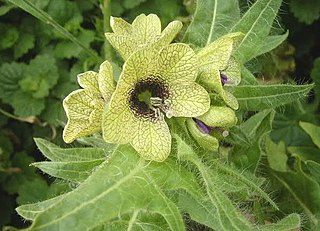
The desert lark breeds in deserts and semi-deserts from Morocco to western India. It has a very wide distribution and faces no obvious threats, and surveys have shown that it is slowly increasing in numbers as it expands its range. The International Union for Conservation of Nature has rated its conservation status as being of "least concern".

Avicennia marina, commonly known as grey mangrove or white mangrove, is a species of mangrove tree classified in the plant family Acanthaceae. As with other mangroves, it occurs in the intertidal zones of estuarine areas.

Hyoscyamus — known as the henbanes — is a genus of flowering plants in the nightshade family, Solanaceae. It comprises 31 species, all of which are toxic. It, along with other genera in the same family, is a source of the drug hyoscyamine (daturine). Cruciferous type of stomata is present in Hyoscyamus.

Melhania is a genus of small shrubs or herbaceous plants. Traditionally included in the family Sterculiaceae, it is included in the expanded Malvaceae in the APG and most subsequent systematics. The genus is named for Mount Melhan in Yemen.
Castellia is a genus of African and Eurasian plants in the grass family. The only known species is Castellia tuberculosa, native to southern Europe, northern and northeastern Africa, and southwestern Asia.
Melanocenchris is a genus of Asian and African plants in the grass family.

Ficus palmata, the Punjab fig, or "Bedu" is a plant in the family Moraceae. It is native to southern Egypt across to north-eastern tropical Africa and also the Arabian Peninsula. It is a shrub/tree with edible fruit.

Tephrosia apollinea is a legume species, native to southwest Asia and northeast Africa.

Between June 2019 and February 2022, a major outbreak of desert locusts began developing, threatening food supplies in East Africa, the Arabian Peninsula and the Indian subcontinent. The outbreak was the worst to hit Kenya in 70 years, and the worst in 25 years for Ethiopia, Somalia, and India.

The South Arabian fog woodlands, shrublands, and dune is an ecoregion in Oman and Yemen. The fog woodlands lie on mountainsides which slope southeastwards towards the Arabian Sea. The mountains intercept moisture-bearing winds from the Arabian Sea, creating orographic precipitation and frequent fogs that sustain unique woodlands and shrublands in a desert region.

The South Iran Nubo–Sindian desert and semi-desert ecoregion covers the northern coastal plain of the Persian Gulf and the inland desert hills south of the Zagros Mountains of Iran. The region also has extensions reaching into southeastern Iraq, and eastward into southwestern Pakistan. The region is one of hot sand deserts, shrubland, and open thorn woodlands inland. Mangrove forests and swamps are found along the coast.

The Red Sea Nubo–Sindian tropical desert and semi-desert ecoregion covers extremely arid land along the northeastern Red Sea, the southern Sinai Peninsula, and on a thin strip along the Israel-Jordan border. Most of the coastal land is flat, but there are high mountains in southern Sinai. Biodiversity is limited by the low moisture levels – some areas go for years without significant rain. Portions of the area support a thin savannah-like cover of widely scattered trees and scrub, surrounded by grasses that briefly flourish after a rainfall. Biodiversity is highest in the mountains of Sinai, and in the wadis and gullies that retain moisture.

Al Hajar montane woodlands is a temperate grasslands, savannas and shrublands ecoregion in the Hajar Mountains of the eastern part of the Arabian Peninsula, which extends across portions of Oman and the U.A.E.

Seetzenia is a genus of flowering plants belonging to the family Zygophyllaceae.
Digera muricata is a species of flowering plant belonging to the family Amaranthaceae. It is the sole species in genus Digera. It is an annual native to parts of Africa and Asia, ranging from Egypt to Tanzania in eastern Africa, and to Madagascar, the Arabian Peninsula, Afghanistan, the Indian Subcontinent, Myanmar, southeastern China, Sumatra, Java, Sulawesi, and the Maluku Islands.
Savignya is a monotypic genus of flowering plants belonging to the family Brassicaceae. It only contains one known species, Savignya parviflora(Delile) Webb

The Arabian great shrike is a non-migratory subspecies of the great grey shrike found mainly in the Arabian Peninsula. Formerly considered a subspecies of the southern grey shrike complex, it is now classified as a subspecies of the great grey shrike.

Euphorbia larica is a semi-succulent shrub or subshrub native to southern Iran and the south-eastern part of the Arabian Peninsula. In the United Arab Emirates it is commonly known as isbaq.
Evotrochis is a genus of flowering plants in the primula family, Primulaceae. It includes seven species of perennial plants native to western Asia and northeastern Africa, ranging from southeastern Turkey to Nepal, and to the southern Sinai Peninsula, the southwestern Arabian Peninsula, and the Horn of Africa.













